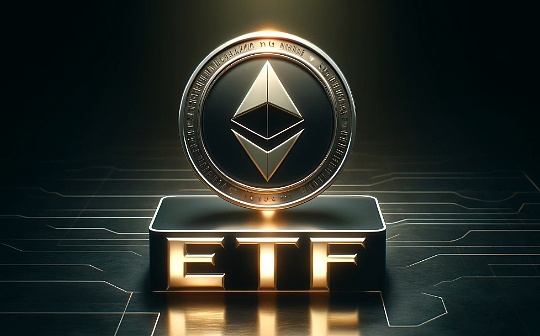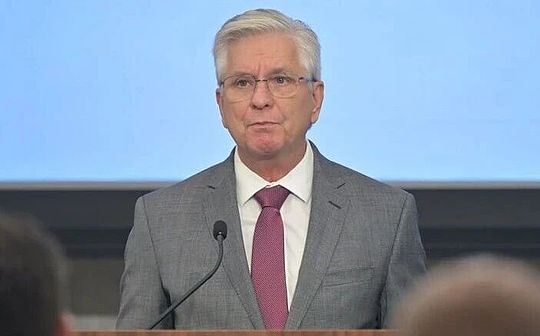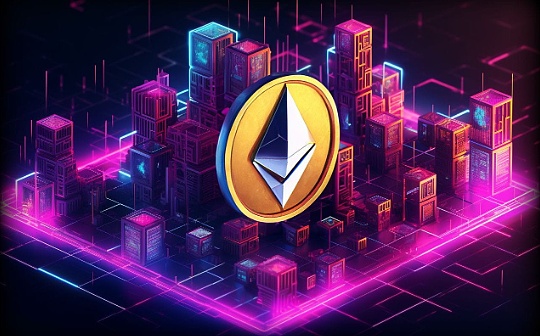
Source: Blockchain
Why must liquidity flow seamlessly?
Last weekend, all my Farcaster friends were talking about a popular new currency, DEGEN on Base.I felt FOMO (Fear lost emotions), I checked my Rabby wallet to see how much I can invest:

“Cool, I can invest $ 500 to this currency, but I need to sell some other assets. However, what does my investment portfolio look like?”
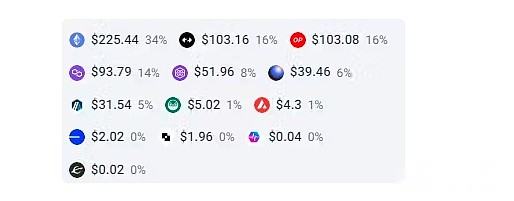

“Oh no”
Almost every token is on different second -level networks.In order to get DEGEN, I must execute multiple in turnbridgingAnd exchange operations, even if the handling fee is very low, this is still a frustrating bridge and exchange process.
We must solve this problem. Our North Star makes the entire Ethereum ecosystem feel like a network.Let’s take a look at the unified liquidity, coupled with the upgrade of the wallet, how to abstract the bridge, and make the second -layer experience of the cross -chain feel like using a single chain.
1. The bridge should not need to do this
WhybridgingSo bad?There are some defects here:
You must access a separate website, connect your wallet, approve the transfer, and pray that it can reach the other end after transfer …
Bridge connections usually take 5 to 30 minutes to complete, which is far too slow.It can be achieved less than 10 seconds, and it is also ideal.
mostbridgingNeed to lock liquidity in two networks.The more the second layer we have, the weaker liquidity.Insufficient liquidity makes it difficult to transfer a large amount of funds between the chains, and the results will make the price lower.
Only some liquid Token can make a bridge. For most networks, this is ETH + stablecoin.
There is also a encapsulated token bridge that does not require liquidity.It can support any token.However, after the bridge, you will get the non -local version of the token you need to need to use the real Token to use any application on the new network. This requires liquidity, so we finally caught the same difficulties.
The most important thing, ifbridgingIt really does not need to be done. Why do we waste it for millions of hours to do it?
2. Wallets and applications should automatically process the bridge
When you use a decentralized trading platform or borrowing agreement, it should track your token on all chains.When you save into the token from another chain, it should automatically connect its bridge to the correct chain in the background, making the whole process feel the same as the Ethereum main network.
Applications and wallets want to achieve this, but the underlying infrastructure is not good enough.If thisbridgingThe process takes 10 minutes, and you lose 1%of the token in the process, most users will be dissatisfied with this experience.
Let’s explore the infrastructure layer in depth to see how to solve this problem.
How to flow seamlessly
In the L2 network, liquidity can be unified through the following three main ways, and there is a enhancement method that can improve their speed.These methods have different signs, but complement each other.
They are:
1) Sharing ecologybridgingTheRealize the liquidity of the entire ecosystem chain seamless aggregation.
2) Casting/destroy token:Can be transferred between any support chain.
3) LocalbridgingMutual trust:Realize seamless aggregation of the liquidity of cross -ecosystems.
Sharing ecosystembridging
When you receive any second -layer network from the Ethereum main network bridge, the process is roughly as follows:
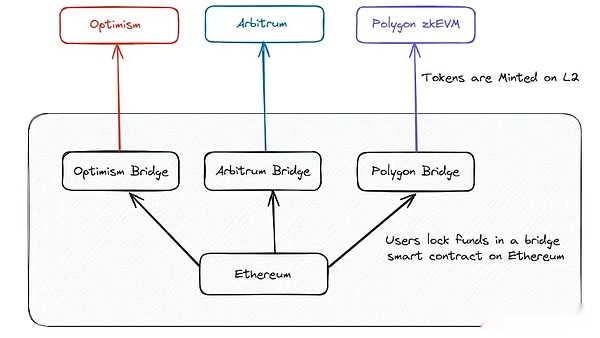
Each bridge is a smart contract on Ethereum, which we call it “local bridge”.whenWhen your bridge receives the second layer of network, your assets will be locked on L1, and a copy will be cast on L2.These networks have the right to cast an unlimited number of assets supported by its local bridge.
Although they have the same name and are clearly called packaging assets, the local bridge of the chain is actually packed from the Ethereum Bridge from the Ethereum Bridge, because the contract address is sometimes different or even the code is different.of.On Ethereum, the USDC contract address starts with 0xa0b8, and starts with 0xaf88 on Arbitrum, starts with 0x0B2C on Optimism, starts with 0xa8ce on Polygon Zkevm.
These assets look the same as that, because wallets and applications have a list of official assets, which contains official images for display, so users will never know the difference.
If it is not for each L2, there is a bridge, but what if they share a bridge?Assets can be cast on a shared chain called the Internet layer, and then cast them on the final destination L2.
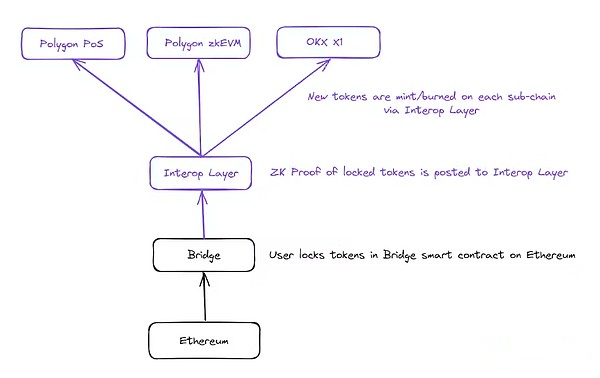
Polygon refers to this new design as “aggregate blockchain”.
What is the use of this design?In this ecosystem, when the assets move from one chain to another, such as from Polygon ZKEVM to OKX X1, there is no need to pass the traditional bridge or first bridge to pick up Ethereum.On the contrary, you can destroy the asset and let the Interop layer cast the same asset on the target chain!
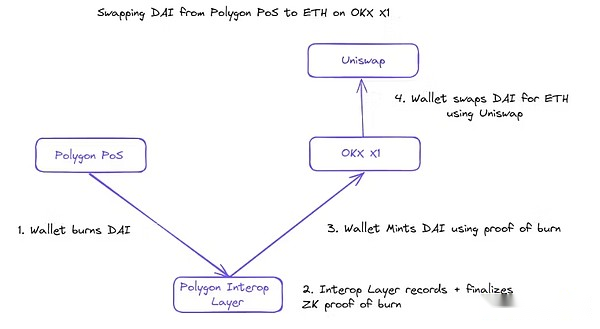
Through this interop layerbridgingEach asset is exactly the same on each chain in the ecosystem.Assuming that the interop layer is free and fast (Polygon indicates that they will be completed in & lt; in 20 seconds), you will be able to freely line assets between any L2 in any L2 in the ecosystem within a few seconds!
Polygon and ZKSYNC are developing this Interop layer design for their ecosystems. It can be seen from the design files of Optimism that they seem to be pursuing this design, although they have not been confirmed.
The disadvantage is that it only applies to one ecosystem, and requires all chains to use onebridgingThis increases risks, but in the ecosystem, the rewards for seamless flowing between all chains in the ecosystem far exceed this shortcoming.
Because all Token is exchanged between the ecosystems, your wallet does not need to display your chain or separates the token according to the chain.On the contrary, your wallet can be like this:
 A unified wallet on a unified chain
A unified wallet on a unified chain
When performing transactions across multiple chains, your wallet can simply show that you are using the “Polygon” network and automatically perform all bridges in the background.
If this design is so outstanding, why not achieve it earlier?ZkIt is proved that it is not possible to be fast and cheap until recently, making it all possible.The interop layer uses ZK to prove all cast/destruction operations, so it can be completed in a few seconds without any challenge period.
Advantages:
-The fast, simple, and standard way to transfer token between chains
-This can move any number of token, no slip point
-It may be free to use
Disadvantages:
-From only in a single ecosystem
-On bridge is a single -point fault/attack target for the entire ecosystem
-In the beginning, design must be made from the beginning, and major changes can be made in the existing ecosystem
3,Casting/destroying Token
Unlike the shared ecological bridge connection, the chain can leave the bridge to the token.Token needs to realize the casting/destroy function and allow users to destroy the token at any time and cast on another chain.
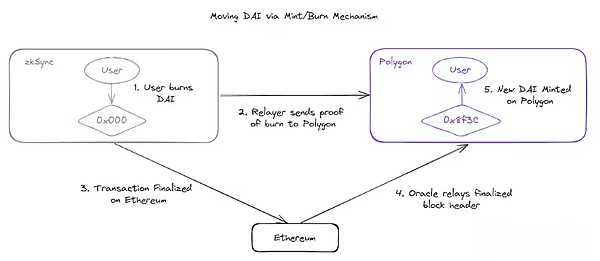
Move DAI from ZKSYNC to Polygon without using Ethereum main network
WillDAIMove from ZKSYNC to Polygon, without using Ethereum main network, you can use Layer Zero or ChainLinkCCIPIntermediate parts such as sending these casting/destruction messages.Layer Zero is developing a project called Omnichain, which will allow Token to implement this function.
Some token has implemented this system.Circle recently launched themCross -chainTransfer protocol (CCTP), this protocol implements this function for USDC between 8 different networks.
Because USDC has high liquidity on many networks and has no liquidity available upper limit, it may be the perfect bridge of mobile assets between chains.The wallet can exchange the token you want the bridge as a USDC, use CCTP to bridge the USDC, and then exchange it back to the token you want on the target chain.This can be carried out in the case of the wallet automatic processing, and it is charged with a small fee or slippery point.
The disadvantage of uniform liquidity to the Token is that it is implemented by some token. Wallets and applications must know which Token can be automatically available.bridgingWhat are not good.
This also requires the token to wait for the final determination of the chain before sending the token. This may take a few minutes to a few hours, depending on the frequency of the data writing of Ethereum.If the token is not waiting for the final determination, it may be doubled, that is, cast on the target chain, and then be revoked in the reorganization of the sending chain.
Another risk that needs to be considered is that the security of Token depends on each chain andrelaySystem security.If a L2 is attacked, it may cast a new Token by sending a token to other chains (for example, claiming it destroyed a token, but it is not actually).The same situation may occur if the token relay or prophetic machine is attacked.This will cause Token to fail in all chains.
ICS-20 is implemented in the cosmos ecosystemCross -chainToken.It solves the problem of “one chain destroys all chains” by tracking the path to the current chain.If tokenx is sent through the chain A -& GT; B -& GT;Still valuable because they do not cross the chain B.This will bring the token alternative additional problem, which requires wallets and applications to solve it, but this is a solution.
Advantages:
-Token can move between any L2 chain freely
-This can move any number of token, no slip point
Disadvantages:
-The chain must be safe, and a damaged chain may destroy the token on all chains
-The wallet must understand the function of each individual token to simplify the user experience
-Token must wait for the final determination to move. It takes a few minutes, sometimes even a few hours
4. Trusted local bridges
The L2 chain with the ZK bridge can achieve fast and free token transfer by trusting other L2 chains.This can be achieved through the user destroy a token on one chain, and then uses the destruction proof to cast the token through the local bridge with another chain.
For example, if Scroll reviews the LINEA bridge and believes that it is safe (and it cannot be unsafe by upgrading), they can set a service to monitor the L1 state root root, allow any user on Linea to release them on Linea destroyed on Linea destroyedToken proof, and this destruction transaction is included in the L1 state root and cast equivalent on Scroll.
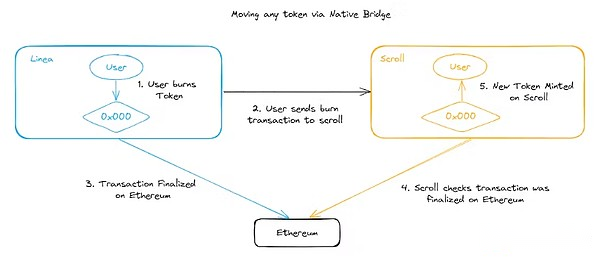
Move any token between two L2, not using Ethereum main network
The process of mutual inspection of the chain has more detailed technical descriptions in this article of Vitalik.
This is first withbridgingBack to Ethereum and then other L2 methods, but this method saves expensive L1 GAS costs.
The current risk is that these prefecture bridges may not be completely consistent with the number of token cast on L2. This is a core attribute that has not been destroyed until now.In the above example, if a user moves a $ 1 million DAI from Linea to Scroll, then the Scroll Bridge will lack $ 1 million DAI. If a user wants to extract a large number of token from the local Scroll Bridge, then it may be possibleThere will be no enough token available.bridgingYou can coordinate these differences through batch L1Token transfer, or always maintain two -way trust between them. Therefore, even if the Scroll Bridge is empty, the big whale can still withdraw funds through the Linea bridge.
Advantages:
-Token can move freely between the trusted chains
-This can move any number of token, no slip point
Disadvantages:
-If a bridge is destroyed, it may endanger all the bridges that trust it
-The number of locks of the bridge may be different from the number of Token cast on its network.This may cause problems when withdrawing funds.
5. Economically and safe and fast certain layer
These three methods have good scalability and security characteristics, but there is a disadvantage to severely slow down the speed of transfer -waiting for the final determination.In the end, it is determined that a block needs to send the network to write its data into Ethereum. This may take up to an hour, and then Ethereum is determined again. This may take up to 15 minutes.
Through economic incentives, we can create “soft final definition”, and one of the transactions is finally determined by nodes with more economic value than its value.This can be implemented by nodes on services similar to Eigenlayer. Their mortgage can be cut and proves that the transaction has been finalized.If the transaction is restored in some way, these nodes will be cut, and this reduction may be used to fill the loopholes caused by restoration.
The advantage of this is that the transaction can be completed in a few seconds and finally determined, which greatly speeds up allCross -chainToken transfer speed.
This is what Near is working hard.Instead of writing the proof of sending/destruction to Ethereum L1 and ultimately determined, on the contrary, it is proved to be written in a NEAR fast determination chain. The final certainty is guaranteed by the pledker of the EIGENLAYER.They will be cut.This tweet thread further introduced its working principle.
Let’s see how this fast determination layer improves all three token transfer methods:
1) The interop layer is already a rapidly determined layer, managed by the ecosystem team (such as Polygon, ZKSYNC, etc.).It allows the transfer in the ecosystem to complete within a few seconds.
2) When the token is cast/destroy between the layers, it is not necessary to wait for the transaction to be finalized on the Ethereum. This may take up to 20 minutes, and the rapid determination layer can prove that the transaction has been completed and will not be restored.If so, the nodes of proof will be cut.The target chain can then trust the layer, and immediately cast it immediately after the transaction is proof.
3) Similarly, when the network trusts each other’s bridges, they can solve the token transfer through this fast -determined layer, not waiting for Ethereum, and can use the proof of the same way as token.
advantage:
-Token transfer can be determined and completed within a few seconds.
shortcoming:
-It is not clear how to repair the loopholes caused by double costs.
-Rele a secondary chain that is not Ethereum to ensure safety.
6. A future wallet experience
After implementing these new unified liquidity improvements, what steps do they feel like using a chain?The remaining two biggest problems are cross -chain GAS and integrated applications with this system.
Cross -chainGAS sharing
If users continue to move between multiple chains, how can they get GAS on all these chains to pay transfer fees?
This is solving through account abstraction (also known as EIP-4337) and payment centers.The payment center is a address that can be required to pay for the transaction fee.Some wallets, such as Avocado and Ambire, allow you to load the GAS balance in advance, and then use this GAS on any chain, similar to a prepaid debit card.
Another simple solution is the BUNGEE Exchange Refuel, which converts the GAS on one chain into a point on another chain.This is worse than the UX in the payment center, which will allow users to leave a little GAS on many chains, but it is effective for the EOA account (standard non -intelligent contract account).
Application of GAS fee
The payment center can also unlock the application to run the payment center and pay all the user’s transaction fee.This will allow anyone to use an application on their own chain without bridge.Applications can make profits in other ways, such as sales of high -end products that require Token, or free demonstration models, but they must pay for a complete experience.
Make applications easily use unified liquidity
Many applications load the user Token balance by calling each known Balanceof on each known ERC-20. This is a slow process and does not support cross-chain.They basically know nothing about the token that may be from other network bridges.
This problem should be solved at the wallet level, so that each application does not have to re -invent the wheels to support the future of multi -chain.EIP-2256 introduces a standard function that can achieve it for wallets, so that all token balances can be loaded at one time, although only a single chain currently supports a single chain.
If a wallet is perceived by multi -chain, and knows the method of bridging from one chain to another, it can immediately tell the application that users have these bridge token, and when the user interacts with the application, the wallet will immediately be immediately immediatelyPerform bridges before performing interaction.This can use any of the above mechanism to bridge the token.
7. Summary
I hope that now you have a better understanding of how smoother flowing between L2, and how wallets use these new technologies to completely get rid of the bondage of the chain, so that Ethereum is as simple as 2020, not as simple as 2020, instead of not in 2020, instead of notIt will be troubled by high GAS costs!

